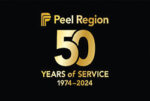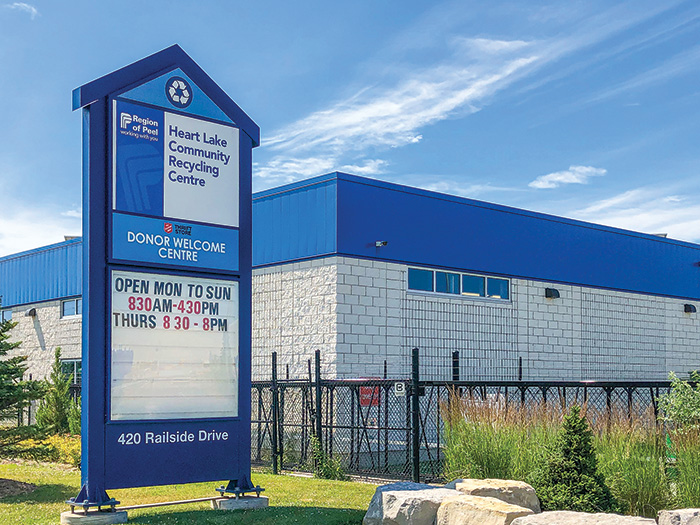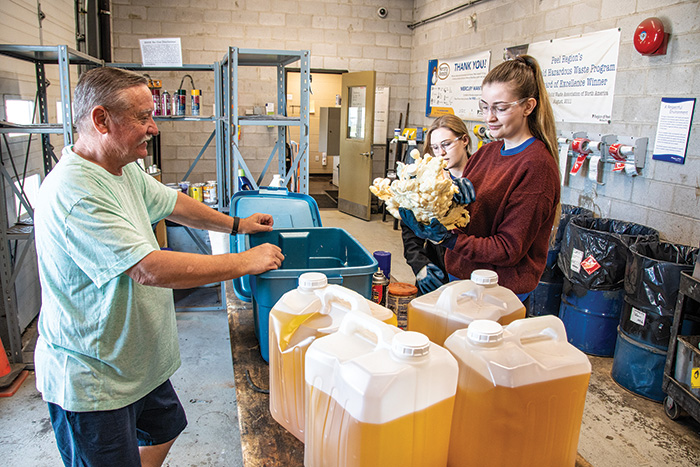Innovative programming and award-winning leadership for five decades have led Peel Region to an internationally recognized Household Hazardous Waste program.
By Brett Slawson
 Welcome to NAHMMA Corner! Peel Region, established on January 1st, 1974, is celebrating its 50th anniversary. Comprised of the cities of Brampton and Mississauga, and the Town of Caledon, Peel has grown rapidly over the past five decades and now services 1.5 million residents and more than 200,000 businesses annually. Throughout Peel’s population boom, it has developed programs to manage the waste generation of its residents and small businesses while maintaining its commitments to waste diversion, resource recovery, barrier reduction, and a circular economy.
Welcome to NAHMMA Corner! Peel Region, established on January 1st, 1974, is celebrating its 50th anniversary. Comprised of the cities of Brampton and Mississauga, and the Town of Caledon, Peel has grown rapidly over the past five decades and now services 1.5 million residents and more than 200,000 businesses annually. Throughout Peel’s population boom, it has developed programs to manage the waste generation of its residents and small businesses while maintaining its commitments to waste diversion, resource recovery, barrier reduction, and a circular economy.
A program developed by Peel during its 50 years of operation is its Household Hazardous Waste (HHW) program. Led by Matthew Stevens, a recipient of NAHMMA’s 2023 Outstanding Personal Service Award, Peel’s HHW program is available seven days a week and features collection depots at six Community Recycling Centres (CRCs). A recipient of the SWANA’s Gold Award for Excellence, the program offers multi-residential service, a curbside collection program, and the reception of hazardous waste from small businesses. With more than 100,000 annual participants, Peel’s HHW program has become an essential waste management service defined by its safe, convenient, and cost-effective disposal methods.

A History of HHW Collection in Peel
In 1979, a 106-car Canadian-Pacific freight train carrying hazardous materials derailed in Mississauga. Shortly after, firefighters on scene found a ruptured rail car transporting chlorine. With the potential of a chlorine gas exposure, Mississauga ordered the evacuation of approximately 200,000 residents. While no injuries occurred, the derailment placed hazardous waste and its safe collection, transportation, and disposal at the forefront of residents’ minds.
In 1984, Peel opened an automotive fluid collection depot, its first HHW collection center. Three years later, in 1987, Peel opened its first HHW Depot. Peel’s first depot offered expanded waste reception, as residents could now safely dispose of toxic and corrosive wastes as well as an extended list of flammable items. Resulting from sustained public interest and participation, Peel developed Conservation Days: pop-up events held twice a year in proximity to residential areas where Peel could dispose of its HHW. Beginning in 1987 and ending in 2019, Conservation Days were held in the large parking lots of schools, government buildings, or office complexes. Conservation Days proved to be very popular, as more than 1,500 residents regularly attended each event to dispose of their HHW and electronic waste, or to donate reusable items to local charities.
As Peel’s population began to soar, it became clear that a single HHW Depot and semi-annual Conservation Days would not be enough. In the 28 years that followed the opening of Peel’s first HHW Depot, six depots were opened. Beginning operation in 1987, 1998, 2003, 2008, and 2015, Peel’s new HHW Depots introduced innovative programs and initiatives designed to eliminate disposal barriers and expand the collection of hazardous waste.

Removing Barriers in HHW Collection
Over time, Peel has introduced programs designed to expand the collection of HHW throughout the Region while simultaneously eliminating barriers to waste disposal. In many cases, residents lack access to transportation, possess a disability, or do not live near an HHW Depot. Offering programs that address these obstacles have allowed for improved inclusivity and program participation. Peel has expanded its safe collection and proper disposal of HHW through the following.
Mercury Roundup
In 2015, Peel became the first Region in Canada to launch a mercury collection program. The program encourages residents to dispose of mercury-containing items such as thermostats, thermometers, blood pressure monitors, and tilt-switches at HHW Depots. Developed in partnership with Scout Environmental, the Mercury Roundup program has collected more than 70 pounds of liquid mercury from Peel.
Curbside Battery Collection
In 2016, Peel launched a curbside collection program targeting single-use and rechargeable batteries. To participate in the program, residents place their used batteries into a clear bag that is then placed atop their organics cart on designated collection days. After collection, the batteries are transported to a Peel CRC, where staff remove forms of contamination before shipping the batteries to a vendor to be recycled. The Curbside Battery Collection program has collected more than 200 tons of batteries from Peel. (Related: Strategies for Curbside Battery Collection: https://wasteadvantagemag.com/the-region-of-peel-on-strategies-for-curbside-battery-collection)
Chemical Cab
Peel’s Chemical Cab program services residents living in multi-residential buildings, low-income housing, and assisted living centers. Buildings participating in the program are provided with waste receptacles, information packages, and educational pamphlets to aid their transition into the program. Once a facility’s receptacles are more than half full, the property manager can contact Peel to schedule a collection. This program successfully supports residents with mobility or transportation restrictions.
Biodiesel Production
In its commitment to resource recovery and reuse, Peel actively produces biodiesel from the eligible waste cooking oils disposed of by residents. Located at the Battleford CRC in Mississauga, Peel’s biodiesel facility produces fuel used to power fleet vehicles and heat Peel facilities in the winter.
Thermostat Recovery Program
Partnering with the Heating, Refrigeration, and Air Conditioning Institute of Canada (HRAI), Peel participates in the Thermostat Recovery Program (TRP). This program encourages residents to dispose of their mercury-containing, electronic, or mechanical thermostats at HHW Depots, where they are received and transported to a vendor for proper disposal.
Business Hazardous Waste (BHW)
For businesses who generate hazardous waste, Peel offers a BHW program. To be eligible for the program, a business must possess a Transportation of Dangerous Goods (TDG) certificate, produce less than 330 pounds of hazardous waste per month, and generate their waste from business practices located within Peel Region. Following an application process, approved businesses are provided with an invoice and drop-off location to dispose of their waste.
Working Towards a Circular Economy
Peel is guided by The Roadmap to a Circular Economy: a closed-loop premise that aims to return all waste to the economy in the form of new products or energy. To create a circular economy, Peel will strive to minimize waste generation, maximize resource recovery, and deliver customer-focused programs. By diverting hazardous waste from landfills to HHW Depots, creating energy from waste-oil and offering numerous programs to residents that reduce barriers to waste disposal, Peel’s HHW program holds a significant role in the development of a circular economy. As Peel moves into its next 50 years and towards its goal of 75 percent waste diversion by 2034, Peel’s HHW program will continue to play a crucial role in waste collection, diversion, and resource recovery. | WA
Brett Slawson is a former Household Hazardous Waste Operator and current Communications Coordinator for Public Works with Peel Region. With seven years of experience in the environmental industry and eight in digital communications, Brett brings first-hand knowledge and experiences to his writing. He can be reached at [email protected].
